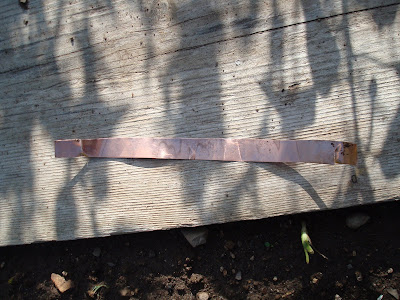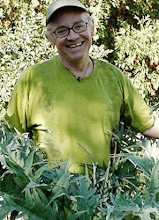
Chive flowers are good for the bees

After the flowers are past and before seed development -

Its time to cut them back and enjoy a second harvest.

Carrot seedlings for transplanting


Garlic Flowers need to be cut off the help make a larger bulb

White wonder alpine strawberries


Vertical tomato growing method.


The tomato patch strung up.

This fruit cluster needs to be thinned before bagging - watch the video

Apples bagged in "Footies" and in plastic - watch those videos

Even with rain, this week was very busy. The rain was much needed and helped to settle the new garden space. Many jobs needed to get done so I started with cutting down the chives. Once the flowers of the chives are no longer attractive to the bees and before the plant spends too much energy making seeds, I cut them back. They will regrow in a few week and we will have nice chives for the rest of the season. I included a before and after to show what I did.
The garlic seed pods need to be removed to get more energy to the bulb. I cut off the flower heads and try to use them in cooking for the week. They are the first garlic harvest since planting last October and are good in eggs and stir fry.
The melons were put out and so were the cucumbers. This year I used peat pots to help reduce transplant shock but by the looks of them they are not happy. I am tempted to start a second planting to see if that will fix the poor growth of this first planting. The melons look especially poor so I gave them a half strength shot of fertilizer today just to see if that would green them up. I planted lettuce under the cucumber/melon trellis because we try to use our space as wisely as possible and there is a nice lettuce space under there. The lettuce will get light until the vines cover the trellis and then because of the way it's set the south end will still get light even when the trellis is vine covered.
Last week's onions are looking better and I pulled some lettuce and transplanted carrots into the spot. I am trying the short nubby types to see if they tolerate the transplanting better. I have two seed sources for Parisian. The beets took to transplanting with little shock and have doubled in size in a week. I have pulled diakon radishes and they have been good. Just a few root maggot scars but pre-punching the holes for the roots seems to work nicely for these.
My white alpine strawberries are going to do much better because of this nice rain. I got rid of all the red ones because Robins know what red strawberries are but have not figured out what white ones are - good!. The slugs don't care about color they just eat anything so there is some slug damage even on these fruits. I grew my plants from seed and they are nice clumps of runner-less plants that will bear fruit all summer.
All the tomatoes have been "strung up". We use a post and twine method to grow the tomato crop vertically and this week it was time to start that process. I have included a video or how I set up the twine and then wind the tomatoes up strings. This eliminates cages and allows me to get my plants closer and keep a single leader growing up the strings. Just a few hints - the best time to wrap and de-sucker your plants is in the evening. In the morning they are more brittle and I have sometimes broken off my top. Also when you snap suckers you are not removing tomato flowers because they occur at another point on the stem. Sucker removal allowes for concentrated vertical growth and opens your fruit to air and more sun for better production and harvest. I will also mulch the whole tomato patch for moisture control as tomatoes will show the effects of insufficient water with blossom end rot and mulching help prevent that trouble.
The rest of the pepper crop was planted today. Once I pull the old spinach out from the hoop house and take the plastic off, then I plant peppers in that spot. Because there is some hope of a new hoop house this year I took the plastic down early. I am going to experiment with copper foil barriers about some of these peppers to see if I can keep the slugs out of them. I found some foil sheets at the arts and craft store and will have to fabricate the circles that sell for $15 in one of the catalogs. Needless to say my copper foil was cheaper and I should get even more than the catalog source amount.
The big job this week is bagging the apples. We have been bagging apples for over ten years. I did research on this process back in 2006 and have been using zipper type bags with one or two staples as a way to keep most apple pests out of my fruit. In the past I have done one spray treatment for Plum curculio but this year I did not even do that. Some of the damage that Plum curculio does can be cosmetic. This year like in the past I try to get the bags on when the apples size up from nickle to quarter size. Those sizes seem to assure that the fruit is pollinated and there is enough seed development, otherwise the tree will drop fruits. One also has to thin the apple crop to get the best production. I do this thinning as I bag while the commercial orchards does the thinning with chemicals.
This year we also are experimenting with using "Footies" those nylon sox that the shoe store uses. These have been used in West coast orchards and last year I tried a half dozed fruits successfully. This year a bought a box and put all 144 on. I used twist ties that were plastic coated from the hardware store and instead of buying a roll of wire and cutting I bought pre cut lengths and cut them in half. I have included both the thinning process on a video and the "Footie" application. The best way to see the plastic bagging process is to go back in the 2009 blog entries to June and there is a video on the June14, 2009 that will show how to bag with plastic.
The apple bagging takes some time and I work at bagging 50 or more apples till I have my three trees done. So far I have put on 144 'Footies" and 150 bags and I still have fruit to bag. With a number of different grafted apples on each tree it is interesting to see which fruits have been hit by the bugs. Some fruit seems never to be bothered and some are always a site for egg laying. I did not do any grafting this season and had to remove a branch with three young grafts from last season because I just did not like the fact that a great portion of the limb was dead. I can always replace the grafts on another branch.
I planted out the five surviving grafted tomatoes and started another batch. I grafted twelve plants and tucked them away into their warm dark environment only to find that the heat mat got TOO warm last night and the plants did not look too good this morning. Oh well, I had enough left over plants to re-graft tops to 8 of the twelve so we will see what happens. I also decided to start another trial by starting the scion seed instead of the root stock seed first and then in a few days I will start the roots stock and see if I can't get better size to the scions.
We have a few videos this week but we have done a lot and want to share those processes.
Happy Gardening
 These first four pictures were show at the 2010 TGOA/MGCA Convention.
These first four pictures were show at the 2010 TGOA/MGCA Convention. These sedums have great color.
These sedums have great color. Pink Pearl heritage apple is a pink fleshed fruit.
Pink Pearl heritage apple is a pink fleshed fruit. Cardoons are wonderful plants and the flowers are amazing at all stages.
Cardoons are wonderful plants and the flowers are amazing at all stages. The 'Earthbox' peppers are looking good.
The 'Earthbox' peppers are looking good. With the cold frames gone the landing is home for the fig tree and 'Earthboxs'.
With the cold frames gone the landing is home for the fig tree and 'Earthboxs'. This is looking like a great use for the greenhouse in summer.
This is looking like a great use for the greenhouse in summer. Nice mature fruits.
Nice mature fruits. This is why I don't snap all the suckers till I am done wrapping the stems.
This is why I don't snap all the suckers till I am done wrapping the stems. Suckers come from leaf nodes and fruiting structures are at a different point.
Suckers come from leaf nodes and fruiting structures are at a different point.

































